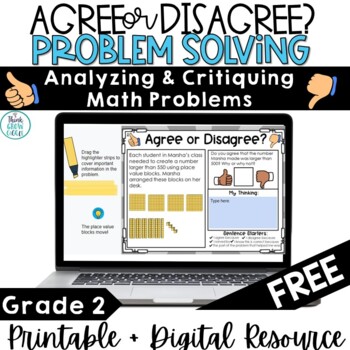- PDF
- Google Apps™
- Easel Activity

Also included in
- Are you looking for 2nd grade math activities to review all the standards? Whether you are teaching 3rd grade and want to review 2nd grade standards during back to school or teaching 2nd grade and want to use these all year, these rigorous, high-interest activities will have your students criticallyPrice $14.50Original Price $17.50Save $3.00
Description
Help your second grade math students get a deeper understanding of how to carefully analyze math problem solving activities and critique the work of others with these error analysis problem solving tasks!
This set includes printable and digital options!
SAVE BIG by purchasing the growing bundle now: Error Analysis Grade 2 Bundle
These mathematical problems reinforce students' reading, writing, and debating skills. Included are agree/disagree cards, as well as math discussion stems and questions to help students engage in meaningful discourse in whole group, small group, or partner settings focused around these problems.
Use as test prep, bell ringers, exit tickets, assessment and learning activities during your math block. Common core aligned.
Included are four sample problems from the Error Analysis Grade 2 Bundle
CONTENTS:
✓4 Error Analysis Problem Solving Practice Pages
✓Student Math Discussion Stems
✓Answer Keys
Suggested Classroom Use:
✓Math centers or stations
✓Small group work and partnership activities
✓Formal or informal assessments
✓Independent practice/Reinforcement
✓Homework or Classwork Review
✓Test Prep
✓Whole Class Bell Ringers/ Morning Work
You might also be interested in these MATH activities:
- Cursive Math Alphabet
- Math Text Me Word Problems Grade 2-3
- Growth Mindset Posters
- Math Practices Posters
----------------------------------------------------------------------------------------
Did you know you can earn TPT $ as store credit just by leaving feedback?
Here's how:
Go to the “My Purchases” page.
Use the provide feedback icon under any item you downloaded.
Click it and you will be able to leave a short comment and rating.
Each time you provide feedback TPT gives you credits that you may use to lower the cost of any future purchases.
It’s that easy!
Thank you in advance as your feedback is important to me!
----------------------------------------------------------------------------
Follow me by clicking the green star at the top of my store page for notifications of new products and sales. Remember new products are always 50% off the first 24 hours!
Subscribe to my blog for engaging teaching ideas and exclusive freebies!
Follow me on Instagram for behind the scenes views of Think Grow Giggle:
Think Grow Giggle on Instagram
Follow me on Pinterest for more teaching ideas:
Think Grow Giggle on Pinterest
Follow me on Facebook for teaching ideas and flash freebies:
Questions? Email me at ThinkGrowGiggleShop@gmail.com







